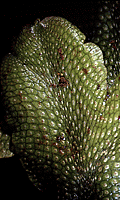







,===== Jungermanniidae (leafy liverworts)
|
,=Jungermanniopsida=|||||| Metzgeriidae (simple-thalloid liverworts)
| |
<<===| `===== Calobryales
|
| ,======= Sphaerocarpidae
`=Marchantiopsida=|
`======= Marchantiidae (complex-thalloid liverworts)
?=== Protosalvinia ![[Extinct]](/bryolab/tree/icons/extinct.gif)
Containing clade(s): Embryophytes
The first published studies ( , , , ) assumed each traditional order to be a monophyletic group and scored characters for these orders rather than individual taxa. However, the Metzgeriales is quite likely paraphyletic and the position of Monocleales, consisting solely of the genus Monoclea, is still debated.
Part of the difficulty in performing a morphological analysis is the relative simplicity of liverwort morphology. Few liverwort taxa have complex tissues or complex structural organization, and each major group has a body plan very different from the others. As a result, only fundamental characters of development can be scored across the complete range of liverwort taxa.
Grolle, R. 1983. Nomina generica Hepaticarum; references, types
and synonymies. Acta Bot. Fennica 121:1-62.
Schuster, R. M. 1992. The Hepaticae and Anthocerotae of North
America east of the hundredth meridian, 6 vols. Field
Museum, Chicago.
Raymond E. Stotler
E-mail: stotler@plant.siu.edu.
Department of Botany, Southern Illinois University, Carbondale, Illinois, USA
Brian R. Speer
E-mail: vespirus@socrates.berkeley.edu.
Museum of Paleontology, University of California, Berkeley, California, USA
Correspondence regarding this page should be directed to Brian R. Speer, at vespirus@socrates.berkeley.edu.
Page copyright © 1999 Brian R. Speer
Last saved 26 August 1999